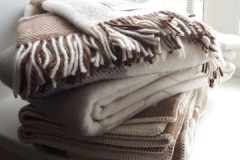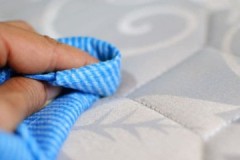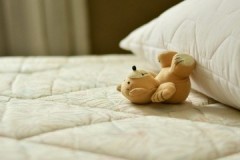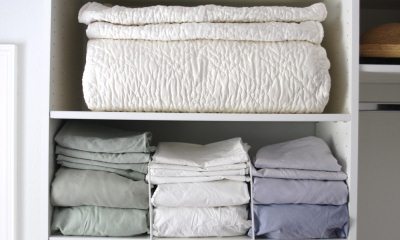 What could be more pleasant than relaxing in a clean bed, on soft pillows, and a comfortable mattress. To prevent rapid wear and tear of bedding, they need to be properly cared for.
What could be more pleasant than relaxing in a clean bed, on soft pillows, and a comfortable mattress. To prevent rapid wear and tear of bedding, they need to be properly cared for.
How to wash bedding? The secrets and subtleties of washing blankets and pillows, mattress covers and blankets, and bed linen will help you enjoy their appearance and positive qualities for as long as possible.
Content
General rules for washing in a washing machine and by hand
Before you start washing home textiles (blankets, mattress covers, bed linen, blankets and pillows), It would be a good idea to familiarize yourself with the general rules and recommendations:
 Before washing, be sure to study the manufacturer's label. It contains basic information about materials of manufacture and washing features.
Before washing, be sure to study the manufacturer's label. It contains basic information about materials of manufacture and washing features.- It is important to adhere to the temperature regime. For natural fabrics, the water temperature for washing usually does not exceed 60°C, for synthetics - no more than 40°C, for delicates - no more than 30°C.
- Wash bedding only with liquid detergents. The exception is bed linen, for washing which ordinary bulk powders are suitable.
- Regardless of the type of fabric, home textiles are rinsed at least twice. This will help avoid stains on the fabric and possible allergic reactions on human skin and mucous membranes.
After washing, do not rush to pack the bedding in the closet. You must wait until the wet laundry is completely dry. Otherwise, things will be irrevocably damaged by mold and mildew.
How to wash bed linen?
Wash bed linen so that it retains its appearance longer It’s not difficult if you follow some rules:
- Before washing, laundry must be sorted by color and type of fabric.
- Heavily soiled laundry is pre-soaked in a detergent solution (for at least two to three hours). Old stains must be removed before washing.
- The laundry is loaded into the washing drum loosely (about a third). This will help you rinse out the laundry detergent better and wring out your clothes.
- Depending on the type of fabric, the required washing mode and water temperature are set. For cotton products - 60C, synthetic fabrics - 50C, linen can be washed at a temperature of 70-90°C.
- The detergent composition is selected based on the color of the bed linen (separately for colored or white fabrics).
The rules for washing bed linen are described in detail in this section.
Mattress
Unfortunately, you can’t wash a mattress as easily as bedding. This is one of the types of bedding that cannot be completely wet (full information on the cleaning method should be found on the manufacturer's label).
 Those who do not have access to dry cleaning services can use the reminder: How to clean a mattress yourself at home:
Those who do not have access to dry cleaning services can use the reminder: How to clean a mattress yourself at home:
- the mattress is placed in the bathroom so that water drains from it;
- using a soft sponge or brush, treat the surface of the mattress with a soap solution (shampoo or a special Vanish product is diluted in water);
- After cleaning, the mattress is rinsed with water pressure from the shower and left to dry.
If there are difficult stains or an unpleasant odor on the mattress, a universal, proven product will help remove them.
To prepare it, mix 200 ml of hydrogen peroxide, 3 tbsp. soda and 2-3 drops of liquid soap. The resulting composition is applied through a spray bottle to the stain, left for two hours, after which it is washed off the mattress with water.
Read more about washing mattresses Here, about how to wash urine from a mattress - here.
Mattress cover
You can prevent the loss of the protective properties of the mattress cover after washing, subject to certain rules and recommendations:
- Before washing, you must carefully study the manufacturer's information on the mattress cover label (about materials of manufacture, recommended temperature conditions, type of washing).
- For washing, use only special gels for membrane fabrics. It is strictly forbidden to use conventional washing powders, oxygen and chlorine-containing bleaches (they clog and destroy the structure of the mattress cover fabric, destroying its protective properties).
- Complex, difficult to remove stains (grease, blood, mold) are removed before washing.
You will find all the most useful and important information about washing mattress covers. Here.
Pillow
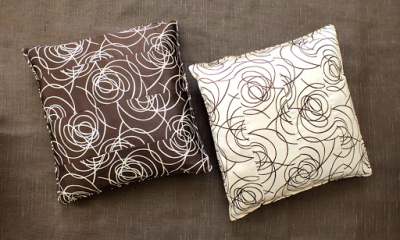 It is possible to maintain the shape and softness of the pillow after washing, provided that certain rules and recommendations are followed.
It is possible to maintain the shape and softness of the pillow after washing, provided that certain rules and recommendations are followed.
The first thing you need to find out is the pillow filling material.. Only pillows filled with:
- may you rest in peace
- wool,
- padding polyester or holofiber,
- bamboo fiber or silicone beads.
The second point that needs to be taken into account when washing pillows is the choice of detergent. Only liquid wool powders are suitable for cleaning pillows. Such products are easily rinsed out of the filler and do not leave marks on the case.
The third point is the washing conditions. Under no circumstances should pillows be twisted in an automatic machine. (only hand rinse and gentle spin). The water temperature should not exceed 50°C.
You will find a lot of useful information on washing pillows in this section.
Plaid
The choice of washing method depends on several factors: the size and weight of the blanket. Light, thin, small synthetic blankets are washed in an automatic machine.
Algorithm of actions:
- set the required temperature (not higher than 40C), the number of spin speeds (no more than 400), add liquid detergent, wash mode - delicate;
- a blanket pre-cleaned from dust is loaded into the drum;
- Upon completion of washing, the product is immediately taken out and hung to dry in a well-ventilated place, away from direct sunlight.
Heavy plush, large blankets are washed only by hand (or sent to dry cleaning). It is important to note that the weight of a wet blanket should not exceed the technical parameters for loading a washing machine (no more than 6 kg).
Blanket
Like any other home textile, a blanket requires periodic washing. Some tips and tricks will help you do this correctly:
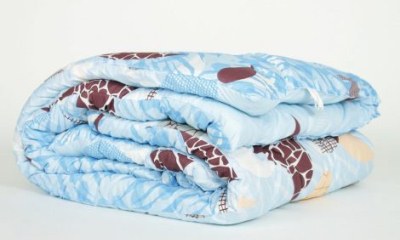 Before washing, you must carefully study the manufacturer's label on the blanket for the recommended type of cleaning and materials of manufacture.
Before washing, you must carefully study the manufacturer's label on the blanket for the recommended type of cleaning and materials of manufacture.- If there are stains on the blanket, they must be removed before washing (a stain remover will come to the rescue).
- If the blanket is small, it can be washed in the washing machine. It is important to adhere to the temperature regime (no more than 40°C), use only liquid detergents, and set the spin speed to no more than 400-600 revolutions. Wash mode: delicate or wool.
Along with the blanket, special balls are placed in the washing drum. This will help prevent lumps from forming. Read more about washing blankets here.
Drying nuances
The main thing to remember is that after washing, the bedding must dry completely.
Drying rules:
- Mattress set out to dry in a well-ventilated place (possibly on the balcony) away from direct sunlight. The mattress takes a long time to dry (at least two to three days). During the drying process, the product is turned over.
- Mattress cover dry only in a horizontal position. This type of bedding should not be dried outside at sub-zero temperatures. Frost (as well as high temperature) destroy the membrane, turning the protective mattress cover into a regular bedspread.
- Blankets dry on a dryer, away from heating devices and direct sunlight, periodically turning on different sides.
Adviсe
 A few tips from experienced housewives will help you achieve the best possible washing quality. bedding:
A few tips from experienced housewives will help you achieve the best possible washing quality. bedding:
- duvet covers and pillowcases are turned inside out;
- Experts also recommend adding fabric softener to the washing machine (it will make the fabric softer and make ironing easier);
- Instead of special liquid detergents for washing pillows, you can use regular hair shampoo.
You will find maximum useful information about washing clothes and various fabric products Here.
Conclusion
Caring for bedding is easy. The main thing is to observe the washing temperature, choose the right detergents and take into account some of the features of cleaning a particular type of home textile.
